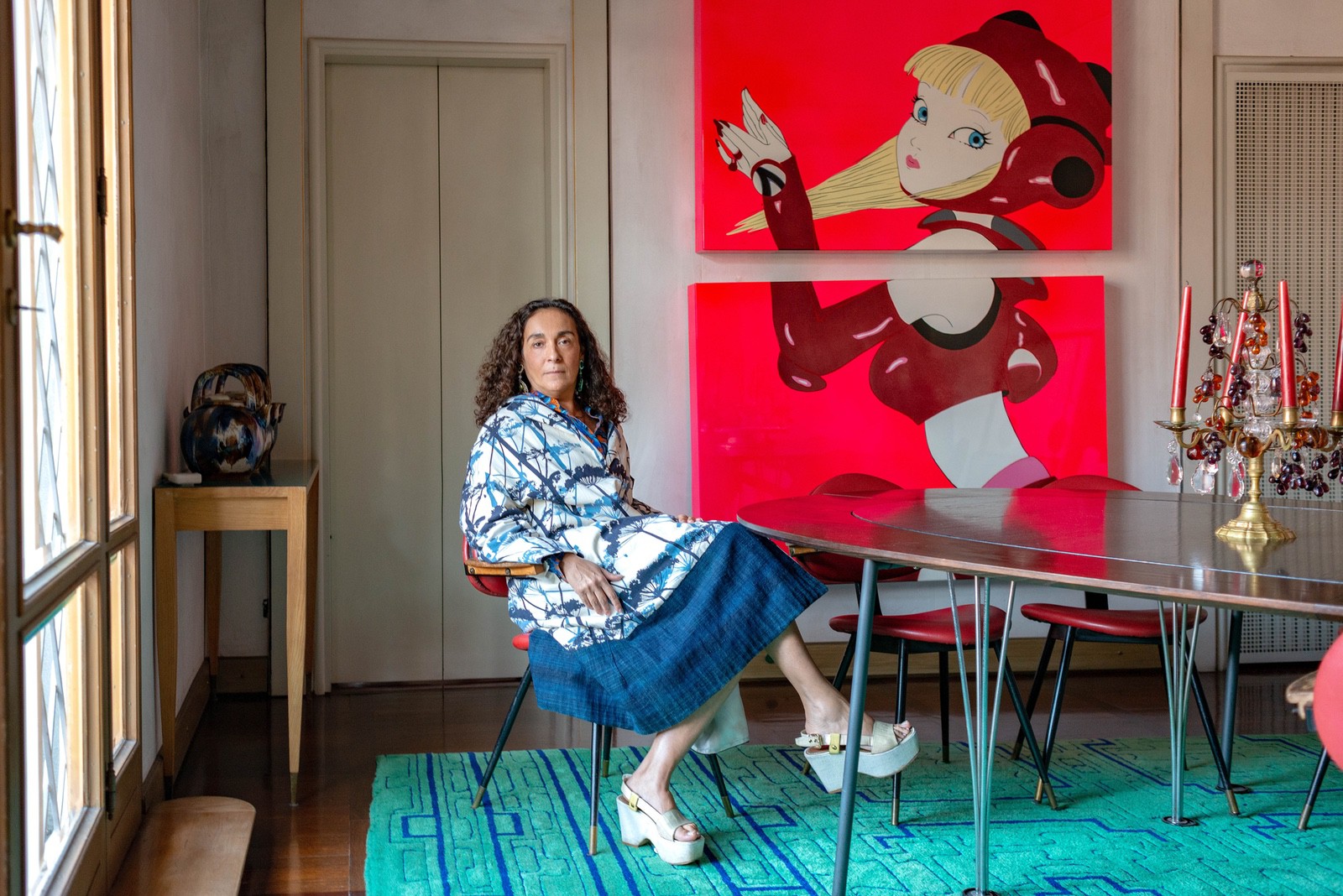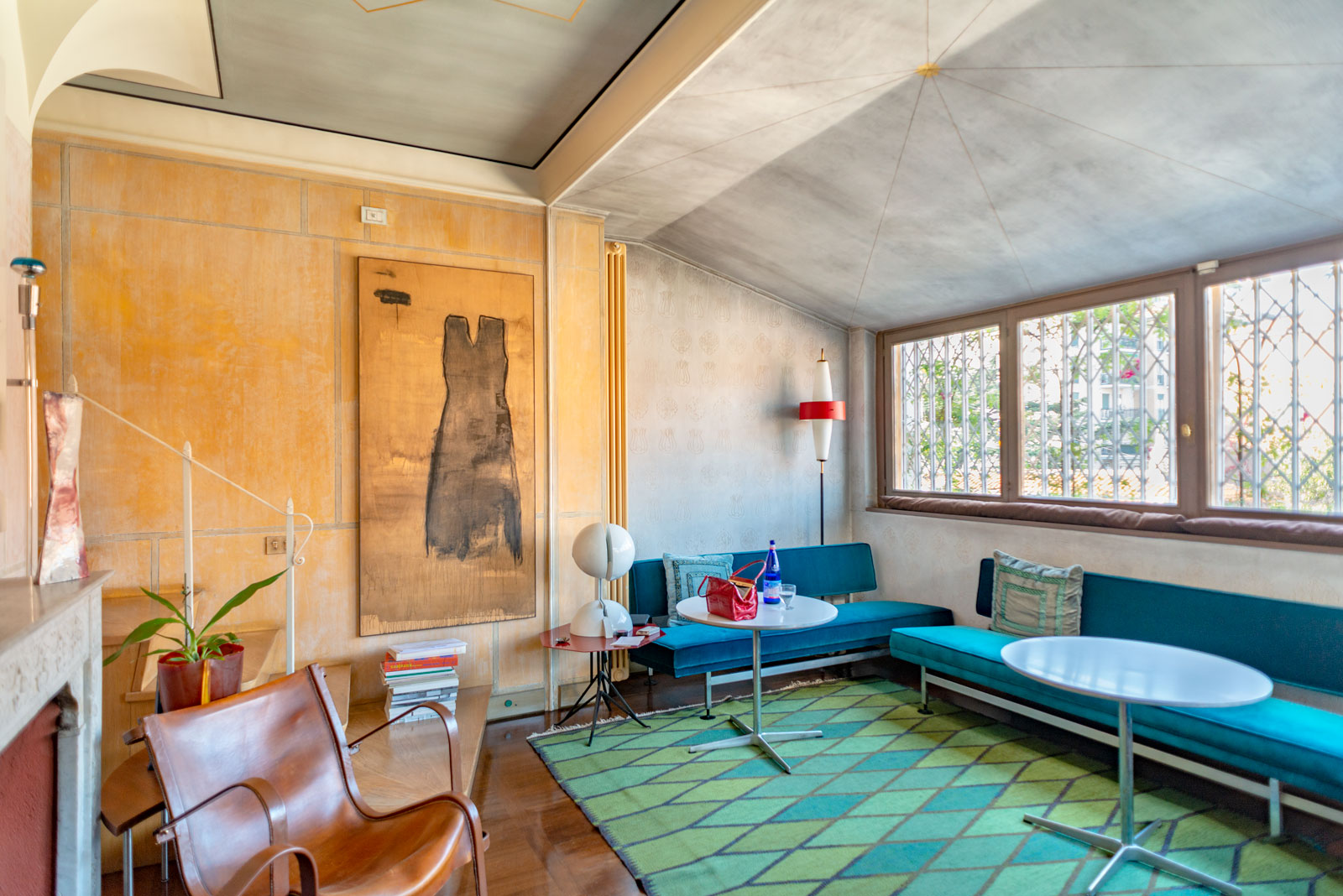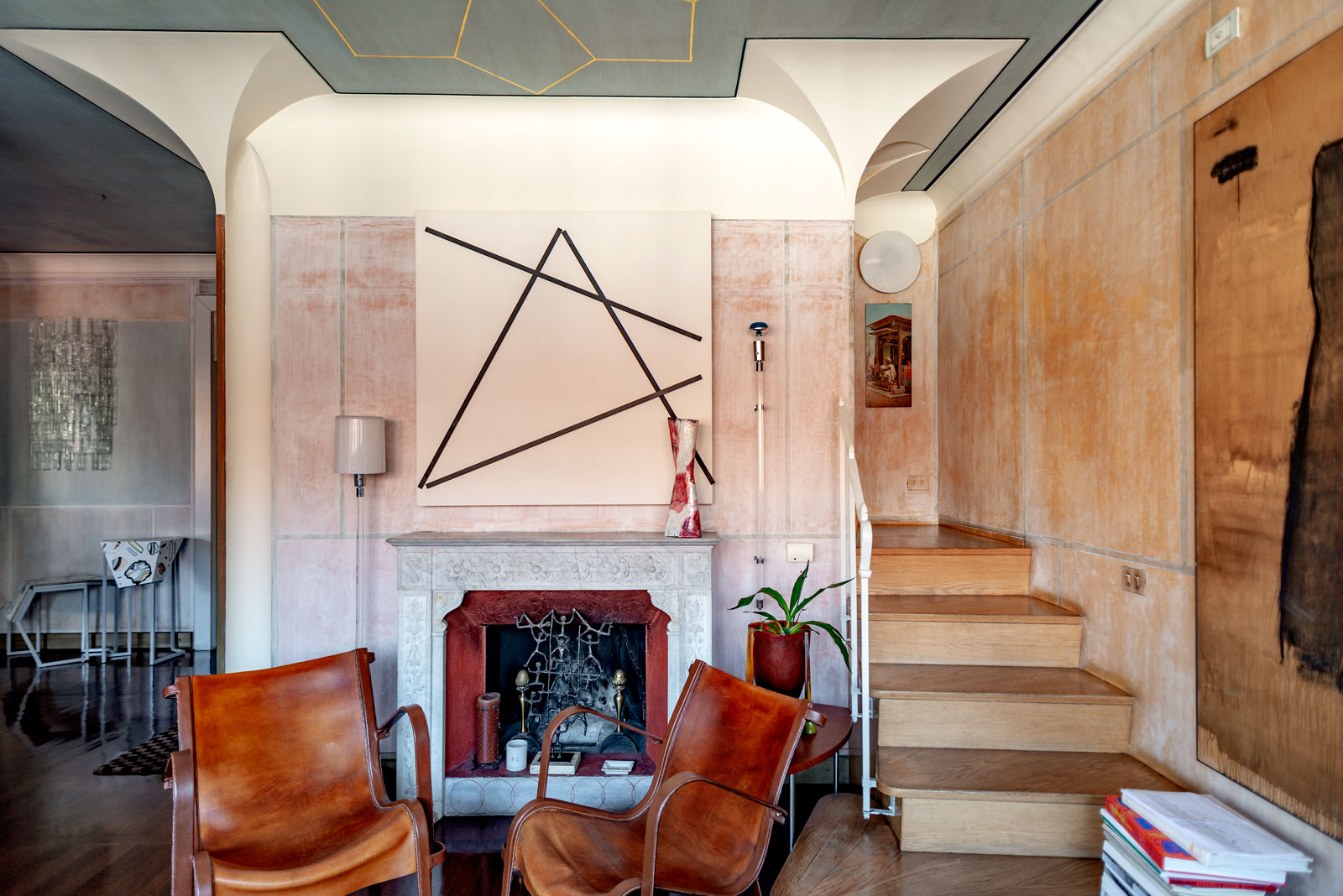Enter Nina Yashar’s home and you enter Nina Yashar’s eclectic universe where Italian Grazia Toderi’s aerial photo of the myriad twinkling lights of London’s night sky is the centrepiece of her collection. In the photograph, the brightest city lights trace luminous geometries on a majestic blue background as if they were simulating celestial constellations. “The artist was thinking of Italo Calvino,” the owner says, and in particular of a city called “Andria” found in his book Invisible Cities, where every street follows a planet’s orbit and all the landmark buildings repeat the constellations of the most luminous stars.

Just as the photograph traces bright constellations, Nina Yashar, owner of Nilufar Gallery, one of the most prestigious design galleries in Milan, has traced her own celestial map with supernovas from a long list of designers that includes Gio Ponti, Jean Prouve, Franco Albini, and Charlotte Perriand and rising luminous stars such as designers Martino Gamper and Laura Bathan Wood. If Nilufar gallery – Lotus flower in Persian- is the sun, the planets orbiting around it are her high profile clients who swear by Yashar’s expertise in successfully combining objects from different designers, different time periods, and different geographical areas — “an obsession I had since I was very young,” she says. At first, she had to think hard about how to combine the pieces,“but now the process feels like a game.”
Her apartment was redecorated twenty years ago. “Back then the tendency of all the best Italian decorators like Lorenzo Mongiardino was to use fabric or paper on the walls, but I wanted to do something different.” That’s when she met jewellery designer Gian Carlo Montebello. “I fell in love with the way he saw things because he wasn’t an architect. Gian Carlo’s specialty is to interpret your soul.” Montebello’s interventions in the apartment -the frescos, the geometrical drawings and the carefully directed brushstrokes- seem as subtle as a ritual whisper. The ceiling is painted in different hues of dark blue and embellished with gold leaf stars evoking the night sky, while the walls are painted in pastel coloured and gold frescoes. Stars and in particular the eight-pointed star prominently found in the murals of the apartment not only reflect cosmic order, but also possibly the owner’s Islamic roots.

Yashar’s family is originally Iranian. She was born in Tehran, but the family relocated in 1963 to Milan, where her father became a leading merchant of Oriental rugs. She worked alongside him for eight months until she turned 21 and decided to open her own business. She started dealing in antique and 19th-century French carpets; furniture design came much later. “I didn’t know anything about design,” she admits. During a trip to New York, while strolling the streets with her agent, she stopped in front of a window and saw a carpet unlike anything she had seen before. She was told that it was Swedish. “I had to go to Sweden!” she says. A month and a half later in Sweden, she discovered the designs of Barbro Nilsson, Marta Maas-Fjetterstrom and Marianne Richter and in three hours she bought twenty carpets. “I had scheduled to stay in Stockholm for three days, but instead in three hours I had my next collection.” At that point her Swedish associate thought why not introduce her to the world of Scandinavian furniture. Together, they visited a huge warehouse filled with furniture where she bought, “just for fun,” seven pieces that turned out to be important Alvar Aalto, Hans Wegner and Bruno Mathsson pieces.
Bruno Mathsson is represented by the oval table of her dining room, where Yashar points to the extension she personally designed. “Osvaldo Borsani had designed furniture with some peculiar extra pieces and I wanted to do the same, but by respecting the original” she says. The table is paired with Carlo Molino chairs acquired from the Lutrario dance hall in Turin, and the ensemble stands on a rare mint-green carpet from Argentina contrasting beautifully with the cartoon painting on the wall that shines a fluorescent pink. “Accompanied by my daughter, I bought this painting during Shanghai’s first contemporary art fair,” she says. Although her daughter, amedical student, was not particularly moved by this painting, Yashar succumbed to temptation and acquired it. “I love cartoons,” she admits with a semi-guilty smile and adds that “the technique is car paint on aluminium”.


Sadly Italians are not chauvinist like the French. In this the French, they are perfect.
Nina YasharThe fluorescent pink reverberates also into the next room with a painting by Danielle Inamorato. A colourful grid painting, a skull, a table and a notebook are all part of an installation Inamorato has designed for what could be a modern interpretation of a 16th century vanitas painting. “I like this because there is a conversation between the artwork and the object”. Yashar loves the idea of a narrative, but she also loves attention to detail such as found by the entrance hall in the two low tables designed by British designer Laura Bethan Wood. “Laura is someone obsessed with precision. Sometimes her thought process is so difficult to follow, but that’s what is genius about her.” Yashar has become her patron since discovering her and occasionally has tried to tame her creative wildness. Her main advice to her has been to “work with simple shapes and forms to balance out the elaborate and very worked surfaces.” Across the Bethan Wood low tables are two high Gio Ponti consoles. Gio Ponti, a major cultural figure, and other designers of the same calibre are, according to Yashar, much more supported outside of Italy than in Italy. “Sadly Italians are not chauvinist like the French. In this the French they are perfect.”
Gio Ponti was also the reason she and Italian Martino Gamper, her other stellar London based designer, embarked upon an adventure. The “If Gio Ponti only knew” project was a performance organised for Miami Art Basel, where Gamper was asked to improvise and reconstruct old Gio Ponti furnishings taken from the Principe di Savoia hotel in Sorrento. Was it risky? “Incredibly” she replies. How would the old establishment react after hearing the news that Gio Ponti furniture was being torn apart and more importantly how would the Ponti family respond? Even though these were pieces no other dealer was willing to buy, the idea was still shocking. The performance was “intense” as Nina recalls, especially since Martino had no preliminary design. Nevertheless the outcome was deemed successful. Back in Milano the Ponti family sent Nanda Vigo, an established Italian designer who, according to Yashar, is “very direct and does not compliment,” to see the re-invented designs. Yashar still remembers with a sense of relief the day the Ponti delegate visited the gallery, looked around, and said, “This Martino did a great job. He really interpreted Gio Ponti.”

Yashar and Gamper met through Israeli designer Ron Arad almost seven years ago. Arad insisted that she meet one of his students at the Royal College of Art and so she travelled to London to meet with him. Three months later she showed his work at the Salone del Mobile. Meanwhile Gamper was working on a project called “100 chairs in 100 days” -100 chairs constructed in 100 days using old discarded chairs. “When I saw this project, I was so shocked emotionally, that I told to my sister that I don’t want to see any more.” Yashar bought the collection immediately and has refused to sell any pieces individually. Since then she and Gamper have built a sturdy working relationship.
Moving from the Gio Ponti consoles to the most expensive piece in her collection, a Fausto Melotti kinetic artwork, she come to stand in front of a shiny golden mosaic backdrop created by the gold tinted frescos on the wall and the matching gold hues found in Pierro Pizzi Canella’s painting. For a moment she becomes a star herself, the subject of a large, imaginary Viennese painting – a woman patron of the arts with Machiavellian intellect and an eye for talent.


Milan, 2012. All photographs and text © 2012 by Alexia Antsakli Vardinoyanni – www.artflyer.net






